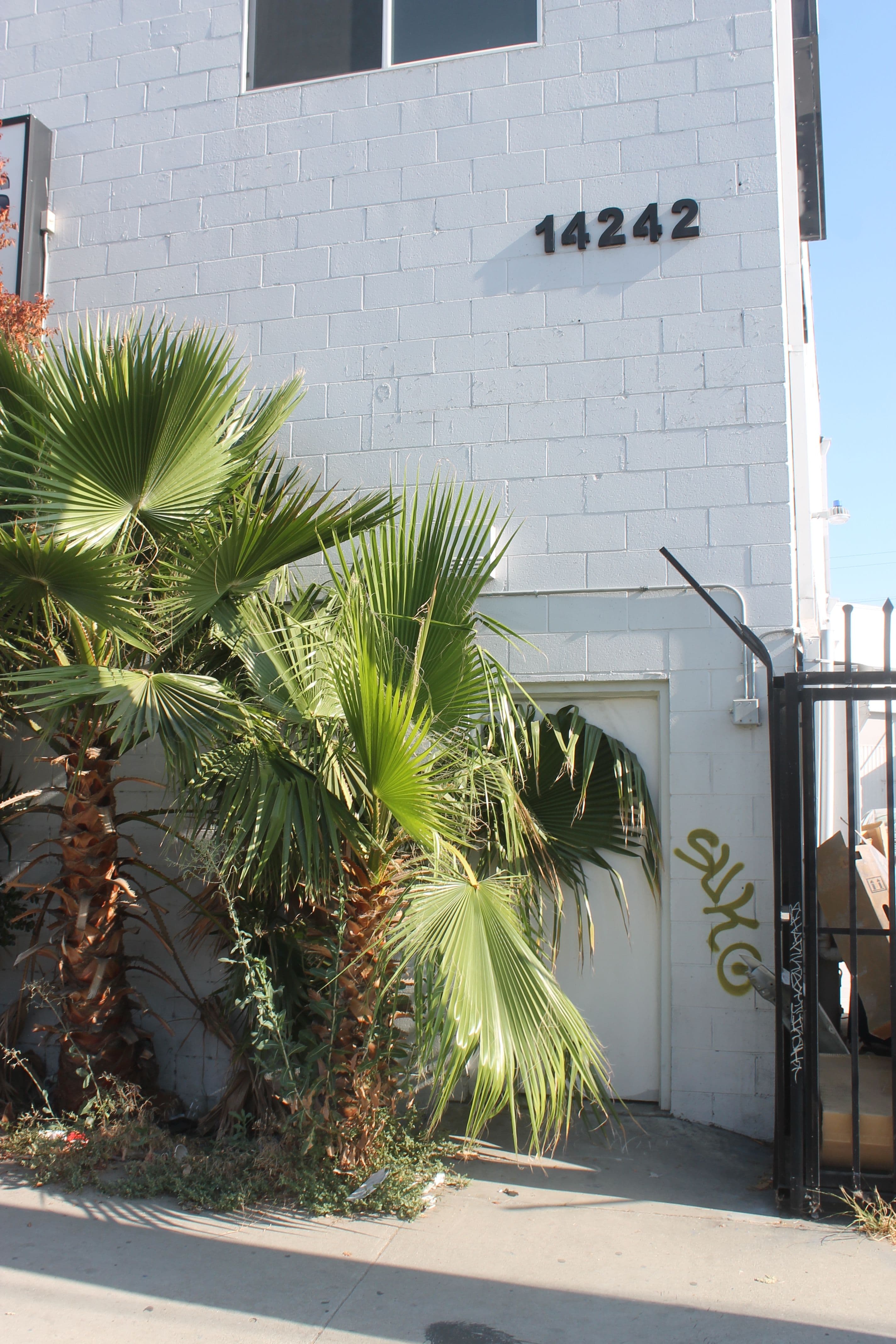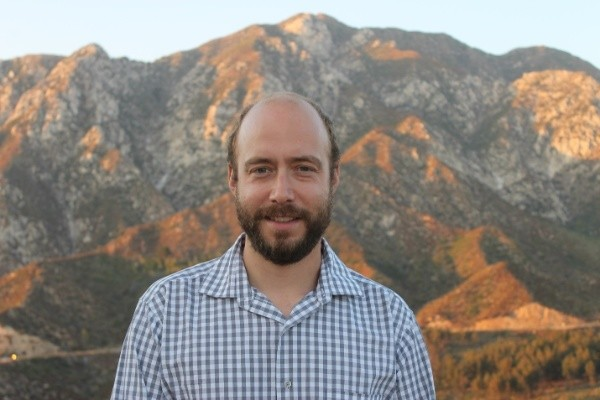With spherical clusters of fan-shaped leaves swaying gracefully atop slender trunks that reach high into the air, no tree is more iconic of Los Angeles than the Mexican fan palm. As an ornamental plant, they can be seen lining streets or planted in loose stands, a bobbing hypnotic mass which perfectly frame an LA sunset. As ingrained into the city aesthetic as they are, it is fitting that these trees are one of the most common wild plants in the urban environment.
Mexican fan palms are native to the central desert of Baja California and Sonora, Mexico, where they are restricted to oases, springs and other areas of constant water. Trees can grow over 100 feet tall, on narrow trunks with flared bases. The fan-shaped leaves are roughly three feet long and wide, with spines along the leaf margins. In the wild, dead leaves cling to the plant, forming a shaggy skirt below the living leaves. Plants flower in spring, sending up long flowering stalks up to nine feet long that are hung with small white flowers. These flowers develop into dark fruits, which are thin-skinned but edible. Beyond California, the Mexican fan palm has naturalized in Florida, Hawaii, Texas and various parts of Mediterranean Europe.
A close relative of the Mexican fan palm (and namesake of the city of Palm Springs) is also cultivated in Los Angeles. The California fan palm (Washingtonia fillifera) is native to oases in the lowland desert of Southeastern California. It can be differentiated from Mexican fan palm by its shorter stature and stouter trunk with a less pronounced flare at the base. The two species hybridize, and the offspring have intermediate characteristics, sometimes making it difficult to distinguish between species. The nomenclature and early botanical descriptions of Washingtonia species are mixed up, reflecting the confusion of early botanists about their origins. The original description of Washingtonia robusta states that it "originates from the Sacramento River in California", a place where no palm species are native. The author was probably describing cultivated trees instead. S. B. Parish made an attempt to clear up this confusion in 1907, but only added to it, mixing up the native origins of the different species and creating several new names which are no longer used by botanists.
Naturalized fan palms in Los Angeles are often small, gnarled saplings growing out of the minutest cracks in concrete or asphalt. But in some areas, such as the Arroyo Seco in Pasadena, they have grown to their full stature in wild stands that rival the height of their landscaped brethren. Unlike most cultivated plants, which have their dead leaves removed, these naturalized stands wear skirts of dead leaves like those one would encounter in native stands in the Mexican desert. These shabby assemblages of dead leaves can also be seen on old palms growing in private lots where the residents don't want to pay to have them trimmed. They look majestic in the right conditions, but are a fire concern, and tend to harbor rats and other unwanted wildlife. The tenacity of wild trees is impressive; it's not uncommon to see a plant several feet tall growing out of a sidewalk crack. Before they develop their fan-shaped leaves, young seedlings grow a simple linear leaf. These are found all over the city, often tattered, dusty and sun-bleached, poking out of sewer grates, streetside planter beds and pavement cracks.
A study on the use of forest resources in the Sierra de la Languna, within the Mexican fan palm's native range, documents the use of fan palm leaves for roof thatching and trunks for house beams. The authors considered it to be one of the most highly exploited species in this area, and recommended investigating the feasibility of establishing local plantations to minimize over-exploitation. This tree, considered a nuisance in Los Angeles, is so valuable in the mountains of Baja California as to be threatening to wild populations, an interesting example of the great disparity in urban and rural realities. After storms or windy days, the streets of LA are littered with dead leaves, which are so slow to break down into compost that they are banned from municipal green waste streams. Rather than being used as thatching for roofs, many leaves which have fallen in LA end up in the landfill.
In Trees in Paradise, Jared Farmer gives a fascinating breakdown of the history of palm trees in Los Angeles. He documents the changing horticultural trends in the city, from the early days when California fan palms were the plant of choice, to the rise of the Canary Island date palm, to the mass plantings of the Mexican fan palm which occurred just in time for the 1932 Olympic Games. These mass plantings are the sources of the tall palm trees which dominate the LA skyline today. They are also the source of parentage for the many wild seedlings which grow throughout the city. Farmer goes on to describe the subsequent backlash in the 1950s when suburban developers moved away from palms in favor of trees with a more generic 'Anytown, USA' look, and the quick resurgence of the palm as a complement to postwar modernist architecture. To provide context for the palm as an LA institution, he quotes Peter H. King, an LA Times editor who in 1992 used the palm as a metaphor for the complicated city of Los Angeles: "My colleagues and I always were looking for the perfect Los Angeles logo, a singular image to evoke the city in all its wonder and misery... We tried out a lot of them, but never did we do better than a palm tree with bullet holes."

The metaphorical power of the fan palm predates Californian statehood. An 1848 article in the California Star, San Francisco's first newspaper, is entitled The Gourd and the Palm Tree. By today's standards, it is a strange article:
"A gourd wound itself around a lofty palm, and in a few weeks climbed to its very top. 'How old mayst thou be?' asked the new comer. 'About a hundred years,' was the answer. 'A hundred years and no taller! Only look, I have grown as tall as you in fewer days than you can count years.' 'I know that well,' replied the palm. 'Every summer of my life a gourd has climbed up round me, as proud as thou art, and as short lived as thou wilt be.'"
Many of the lofty Mexican fan palms of modern-day Los Angeles are approaching the 100 year mark, and perhaps the end of their natural lifespan.
Palm trees have such importance in Los Angeles that an entire neighborhoodon the Westside is named for them, and much has been written about their role in defining the city as an exotic, glamorous destination. Nonetheless, the future of palms in the city is uncertain. Journalists have documented a slew of diseases and pests which threaten the health of certain palm species, while price increases of nursery plants decrease their affordability for municipalities and lead to city council decisions opting for leafier trees in median plantings. Many Mexican fan palms in LA are nearing the end of their lives, and new ornamental plantings are rare. It seems inevitable that the LA skyline will change, and the classic sunset view of swaying palms may disappear in the future. What these articles don't mention is the success of the Mexican fan palm as a wild plant of the streets. Long after the last planted tree falls, their gnarled, sidewalk-crack offspring will persist, dominating the Los Angeles aesthetic in their own way.
